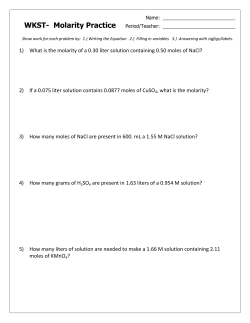
CHEM 139: Exam 5 Study Guide
CHEM 139: Exam 5 Study Guide Chapter 18: Oxidation-‐Reduction (Redox) Reactions • Be able to determine oxidation numbers for all the elements/atoms/ions in a chemical equation. • Use oxidation numbers to determine if a chemical equation represents a redox reaction. • Use oxidation numbers to determine which reactant was oxidized (lost electrons) and which reactant was reduced (gained electrons). • Write half-‐reactions to determine the number of electrons transferred. Chapter 9: Quantities in Chemical Reactions Stoichiometry: Use mole-‐to-‐mole ratios to relate and calculate amounts of reactants and/or products in a chemical reaction • Solve mass-‐mass stoichiometry problems. Limiting Reagent Problems • Calculate the mass or volume of product that can be made using the given amounts of each reactant and the balanced chemical equation. – Solve for the limiting reactant using the comparison-‐of-‐moles or comparison-‐of-‐mass method (i.e., determine if there is enough of one reactant to react completely with the other) • Indicate the limiting reactant (or reagent) and the reactant(s) in excess. • Calculate the amount of reactant in excess that remains after the reaction. • Use conservation of mass to calculate the mass of reactant in excess that remains after the reaction or the mass of product(s) that form(s). Yields of Reactions • theoretical yield: amount of product predicted using the balanced equation when limiting reagent is used up (can be calculated) • actual yield: amount of product one actually obtains (generally given in the problem) Percent yield = actual yield × 100% theoretical yield • Solve for the percent yield given the actual yield and solving for the theoretical yield. • Solve for the mass of reactant needed to get an actual yield or product given the percent yield and the balanced chemical equation • Solve for the mass of product actually produced given the initial amount reactants, the balanced chemical equation, and the percent yield Mass Percentage Problems • Use stoichiometry to calculate the mass or mass percentage of a compound in a mixture. CHEM 139: Exam 5 Study Guide page 1 of 2 Chapter 15: Solutions • solution: uniform mixture of two or more substances as atoms, ions, or molecules – a solute dissolved in solvent • Know how temperature and pressure influence the solubility of gases and/or solids in solution. • Recognize what occurs at the molecular level when a solute dissolves in water. • Recognize why the following can increase the rate of dissolving a solute in a solven: § heating solution § stirring solution § grinding solute into smaller particles • Know the definitions for unsaturated, saturated, and supersaturated – Explain how to prepare a supersaturated solution given the increased solubility of a solid in a liquid at higher temperatures • Use “Like dissolves like” Rule and the Solubility Rules to predict what substances are soluble/insoluble in or miscible/ immiscible with water or other solvent Molarity= moles&of&solute (units of M=molar) liters&of&solution Mass Percent Concentraton (M/M%): M/M%= mass$of$solute x100% mass$of$solution Molarity, Mass Percent Concentration, and Solution Stoichiometry Calculations • Solve for amount of solute, solvent, and/or solution given molarity, M/M%, etc. • Use molarity and volume to solve for moles • Calculate the molarity of ions in solution (based on number of ions present in a compound) Dilution Equation: M1 V1 = M2 V2 -‐ Account for new total volume when a solution is diluted with deionized water -‐ Calculate the required volume of a compound in solution to produce a given concentration of a compound or an ion in solution. -‐ Calculate the molarity of a compound or an ion in a diluted solution. You will be given a copy of the CHEM 139 Periodic Table with elements symbols, atomic numbers and atomic masses. Be able to solve problems combining topics from current and previous chapters. CHEM 139: Exam 5 Study Guide page 2 of 2
© Copyright 2025









